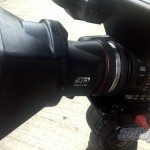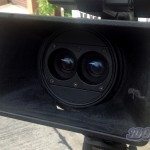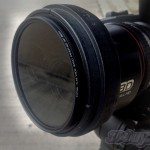When I say wizard many visions may spring to mind. Ken Burgess is truly a wizard. He’s not a pinball wizard and although his long flowing white hair and beard may remind you of a modern-day Gandolf, he doesn’t have any Hobbits running around his house.
No, Ken is a 3D Optical Wizard. He views things in a different way. Armed with his knowledge of optics and 3D he creates attachments that improve and expand the use of modern single body 3D video cameras.
We’ve all looked at the three cameras that come out and said we wish you had this and we wish it had that. Well Ken has taken some of those wishes and brought them to life.
What’s more he uses 3D to create 3D. Sound confusing?? Not really Ken uses a 3D printer to produce his 3D creations. Without this device you admits that it would be that he would be hard-pressed to create the molds needed to go through the usual creation process. By printing each one of his creations with his 3D printer he’s able to keep the prices at an affordable range.
Ken makes accessories for the Panasonic, Sony JVC and even the Fuji 3D camera.
Ken was gracious enough to send me some of his creations for me to put to the test. I took them into the field and worked them as hard as I could. The results along with first hand un-retouched video will be appearing over the next week or so in a series called “The Wizard of 3D”.
First though, I will let Ken explain the different devices and their purpose.
“To try to avoid some confusion I wrote up some notes about the products we make for the Panasonic Z10000, the Panasonic 3DA1 and the Sony TD300. While we have tried to make components interchangeable where possible these were all designed at different times and all our decisions may not make perfect sense at the “multi-system” level. Anyway I will address each in turn and point out what works with what.”
“We have three basic product “types”: Base Extenders (we call SBE’s), Wide Angle Lenses (we call WAL ‘s), and Filter Adapters (we call FCA) The “C” in FCA stands for “close up” which I will also explain in some detail.
“So starting with the Z10000, we currently offer a WAL , a EWAL (Extreme Wide Angle, or Fish Eye type lens)and FCA. The lens shade helps a great deal to keep light off the surface of the lenses. The WAL and the FCA both have lens rings that can accept common round filters such as polarizers and variable (or fixed) neutral density filters, star filters and a few other “specialty” type round filters. The ring on the WAL is 95mm and does not vignette with a single filter attached. The FCA has two sets of rings, 37mm over each lens and an 86mm ring that covers both. The FCA also comes with an adapter for 95mm filters. The adapter allows the same set of filters to be used with the WAL and FCA. “Several 95mm round filters can be “stacked” on the FCA if desired.”
“The 86mm ring on the FCA is used “directly” for close up lenses. We could not find a source of 95mm close up lenses, but discovered that 86mm worked fine as long as they were close enough to the lens, they would not work if the unit had a 95mm ring stepped down to 86 because that pushes the close up lens out too far, but going from 86 to 95 is no problem. The purpose of the close up lenses is twofold. First is to allow close focusing (as per normal), but more importantly for 3D the prismatic character of using a single lens “off axis” adds convergence and increases the common scene coverage as you get close to a subject. This technique works great for close-ups or macros as long as the total depth of the scene is limited. It turns out the “Red indicator” on the Z10000 will warn you if there is too much total depth even when the close up lens is used! Quite a nice result really. The range of close up is really more like macro, think just the lips or eyes, but not the whole face. Because the lens spacing is not reduced the depth range must be small, but under the right conditions the results can be absolutely stunning, and not possible to do without the lens.”
“Ok back to filters and shades. We have FCA and WAL which are both compatible with the Century Optics Sunshade with 4×4 Pro Filter holder.”
“All of the “accessories” for the Z10K mount the same way. Your first remove the plastic “hood” on the front of the camera by removing four screws (one in each corner) and pulling the hood straight off. We have been told that the “glass” in this factory hood is actually plastic and causes image degradation. Looks like it could be to me, but in any case our “system solution” is to use just replace it with a FCA that has “UV filters” in the 37mm rings. This protects the lens, and you can leave them in because the larger (95mm) filters fit on over them. The FCA and WAL are attached using a “thumbscrew” type knob on the top of the unit. Just snug it up when you put the adapter on, and loosen it to remove the adapter, no tools required once the factory hood is removed. The lens shades attach to the FCA and WAL in a similar way. The EWAL is very similar to the WAL except that you really can’t use any filters or hoods on it, because the FOV is just too wide (like 160 degrees). It’s really not for “every day” shooting, but can make for some pretty interesting results.”
“On to the Sony TD300. This is our latest product and represents our “latest thinking” in regards to how this stuff all works. For the TD300 we offer a SBE (180mm), a WAL , and an FCA. I’ll talk about the SBE first.”
“The SBE is of course used for “distance shots” or in closer situations where you have complete control of the depth in the scene. For outdoor work with “infinity” in the background the closest object in the frame should probably not be closer than about 3 or 4 meters. The “4X Base Extension” (interaxial on the TD300 is 45mm) should usually be used with a “4X” zoom. The reasoning here is that when you zoom in by a factor of four you increase the size of objects in the frame by a factor of 4, bringing them “closer” in a 2D sense. But since the parallax to the objects is not changed (unless you extend the stereo base) the objects will still appear to be as far away as they were (are). The objects will look “too big” and rather “flat” for the scale of the world, and the depth of the whole scene will appear compressed making the objects in the scene look like cardboard cutouts (“cardboarding”). The reason is that the perceived scale in Z does not match the scale in X and Y, basically the 3D aspect ratio is wrong. Errors in the X/Y aspect ratio are easily noticeable, and quite objectionable if the error is 20% or more. If the Z scale does not match the scale of X and Y spheres (or people’s heads) will look like “cardboard” (FL too long for the SB) or “footballs” (FL too short for the SB). Increasing the stereo base by 4X when you zoom in 4X will maintain a “correct” aspect ratio in 3D space. Fortunately errors of scale in Z are not nearly as noticeable as for X and Y. Where 20% is a practical limit in X/Y, errors of as much as 200% are “tolerable” for Z. Of course you may want to move away from “realism” and distort the scene in Z, but that’s another subject… Anyway, the bottom line is that the SBE helps restore depth when you zoom. You will notice in fact that the SBE cannot be used with short focal lengths, because there is vignetting with focal lengths shorter than about “60” on the TD300’s zoom indicator. 0 on this indicator is a 35mm equivalent focal length (EqFL) of about 40mm (FOV about 48 degrees) 60 on the indicator represents an EqFL of about 110mm, 4X zoom (from 40mm EqFL) is at about 80, the total zoom range for the camera is 6X (at z=99). The TD300 SBE now has custom, removable lens hoods and lens covers on the front (which, incidentally, will work with the A1 SBE too).”
“The WAL essentially halves the focal length of the camera and can be used at any zoom. At minimum zoom (z indicator = 0) the EqFl is 21.5mm with a FOV of 80 degrees. This is pretty extreme, so you may want to “zoom in” a bit for most scenes, although the “z scale distortion” is not as great as one might think because the camera lenses are spaced at 45mm, somewhat less than the (standard) human interocular, which is 65mm. The lenses do introduce a small amount of barrel distortion but that should be pretty easy to accommodate in post. Of course lenses this wide might also exhibit a bit of de-focusing and/or chromatic aberrations at the edges. We have used what we consider to be the best wide angle auxiliary lenses available. They have three elements and are well “corrected”, I think the quality is quite good considering the maximum FOV obtained. However, if you decide not to use the “edges” it may be better to crop in post than to zoom the camera lens, you might want to do a few experiments to determine the best approach as I am not really sure which is better. The large front surface of the lenses in the WAL are susceptible to glare, in my opinion the WAL should always be used with a lens shade. To that end we have made the WAL compatible with the lens shade from Century Optics that I mentioned earlier and include it with the WAL for the TD300.”
“The FCA is very similar to the unit we make for the Z10K, allowing you to use 37mm filters or 86mm close up lenses, or 95mm filters with a step ring. It is also compatible with the Century Optics shade and can be used like a ‘small matte box’.”
“The SBE, WAL , and FCA all attach to the camera using four thumbscrews in place of the screws that were used to attach the “stock” bezel to the camera. This mount on the camera is very sturdy and most convenient for attaching the accessories, however the SBE also comes with a bracket to mount it using “standard” 15mm rods, similar to how the SBE mounts on the Panasonic 3DA1, but on the 3DA1 the rod mount is the only option..Because the TD300 is so large and the tripod mount rather “unusual” we decided to use the “frame” mount instead, which also works very well for the WAL . Note that the SBE is mounted over the stock bezel or the FCA, whereas the WAL mounts in place of the stock bezel. Extra “screw holes” are provided to keep track (store) the stock screws, or the thumbscrews when either is not in use.”
“Finally, to the Panasonic 3DA1. We make two products for the 3DA1, the SBE and a new front Bezel. As mentioned the SBE mounts to the camera using 15mm rods, much like the way a matte box is mounted. We supply the entire assembly with the SBE so nothing further need be purchased, however the mount can be used with other commercial systems that support the standard15mm rod mounts. There is a “Special” bezel that must be used in place of the stock bezel when the SBE is mounted. This bezel can be left on the camera at all times and has an advantage over the stock unit in that it provides access to the lens rings on the cameras used in the 3DA1, for adding filters etc. The other Bezel does the same thing but looks a little better, unfortunately it can’t be used with the SBA. We do not make a WAL for this camera but it’s something we could do in the future. Unfortunately the SBE for the 3DA1 has not been a “big seller”, perhaps hopefully just because no one knows about it.”
With the illustrations and Ken’s detailed explanation it should give you an idea about what is available and what they do.
Next time I will show you what the 3DGuy challenge has shown about these marvelous inventions.
A Little Bit About the People Behind Cyclopital3D
Ken Burgess
Ken Burgess is the CEO, Co-Founder and the Lead Product Design Engineer for Cyclopital3D. Ken holds a Master of Science degree in Electrical Engineering and a Bachelor of Science in Physics, specializing in Optics. Ken has been studying optics for more than 30 years with a special focus on stereoscopic photography and its peripherals for the past 17 years.
Ken co-chaired the 2011 National Stereoscopic Association annual convention with his Cyclopital3D partner, Tanya Alsip. Ken is both a software engineer and a product designer who is always “inventing” something new and making notes about the possibilities in his notebook that he takes with him everywhere. Ken currently holds 7 patents and is mentioned in more than 400 others. If you have any interest in calculations, Ken also has an iPhone application available under the name of “Calchemy” on the iPhone app store.
Tanya Alsip
Tanya Alsip is Chief Financial Officer, Co-Founder and Business Manager of Cyclopital3D. Tanya has a Bachelor of Science in Business Administration with a concentration in Finance and an MBA. She has also spent many years volunteering her financial, marketing and business expertise to various service and non-profit organizations, which is a great passion of hers. Stereo photography is a relatively new interest for Tanya that was sparked and fueled by Ken’s enthusiasm and patience.
By: Al Caudullo
Have a question for the 3DGuy?
Please leave a comment and we will reply to you.
Copyright ©2012 Al Caudullo All rights reserved. The content and photos within may not be distributed electronically or copied mechanically without specific written permission. The content within is based upon information provided to the editor, which is believed to be reliable. Data within is subject to change. Al Caudullo is not responsible for errors or omissions.










Yes, Ken’s made some significant contributions to stereography, and certainly looks like he’ll continue to do just that. I especially enjoy his macro attachment for the W3.